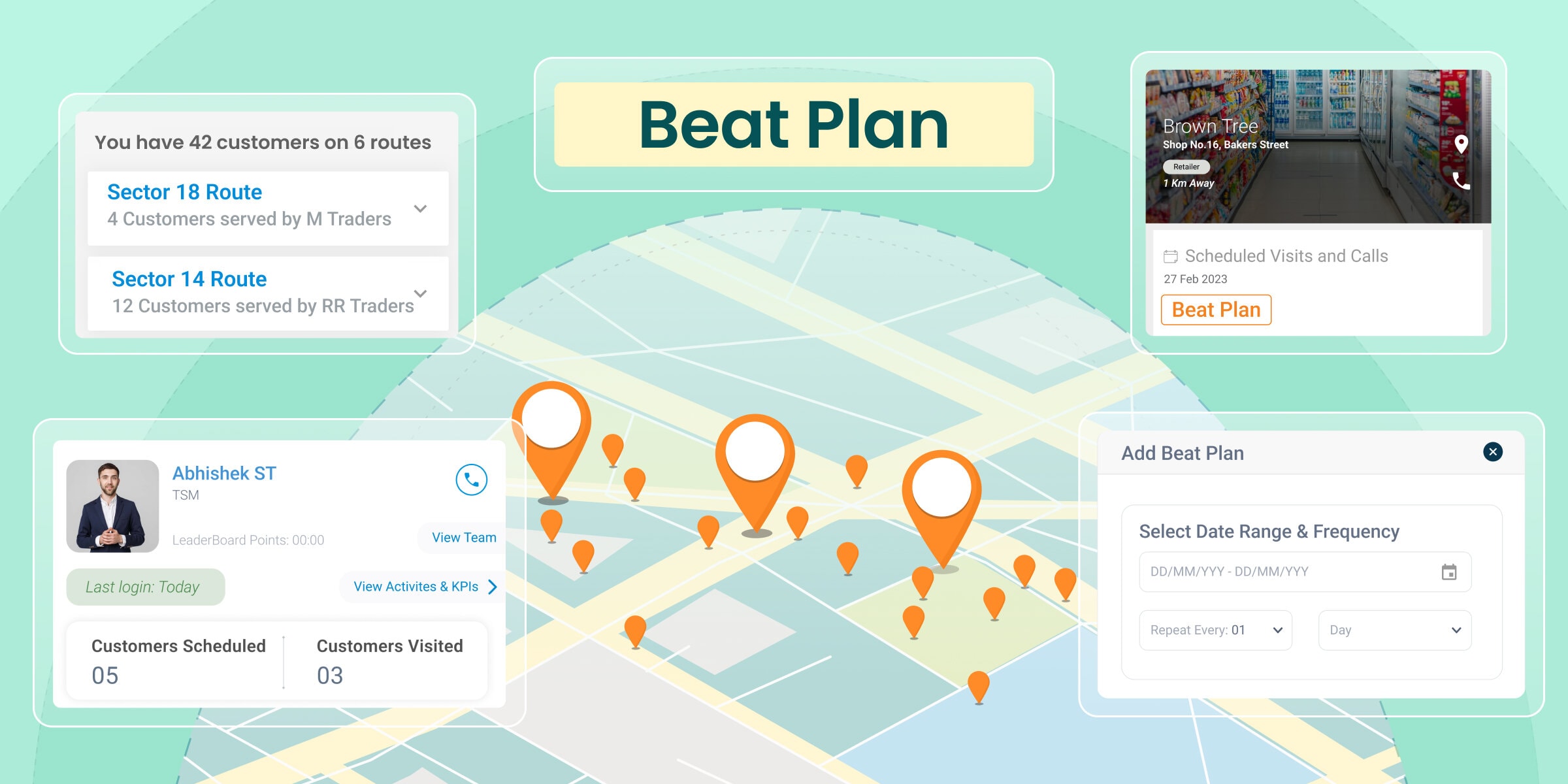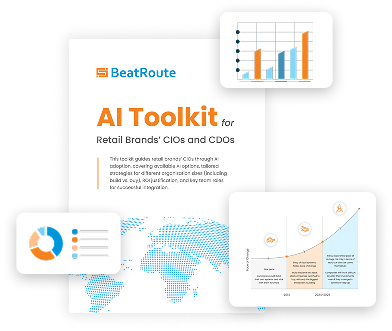The Complete Beat Planning Guide for FMCG Brands

Everything needs order, a way of going about things. Without order, it’s all chaos and missed opportunities, including in retail. While in the field, meeting retailers and dealers, sales reps need to abide by special plans that in the industry jargon are known as beat plans.
What is a Beat Plan?
A beat plan is a predefined order of stores based on store type and necessity that a sales rep must stick to in their daily routine. It helps brands to form human connections with their B2B customers, i.e. retailers and dealers, via sales rep-customer face time that leads to issue resolutions, product intros, and of course, ordering.
Instead of best-guessing the order of shops to visit for the day and losing their way or simply coming up short of a day’s allocation, sales reps can utilise a purposefully designed beat plan to go about their job. An intuitive system that gathers and analyses data, and then prioritises visits based on necessity and urgency could do this for you.
But how exactly is beat planning crucial to your sales? And how do you go about creating the most effective one? Let’s find out so that you can make beat plans productive for your sales operations.
What Makes a Beat Plan Crucial to Sales Operations?
Nothing ever goes according to plan if you don’t have one. A beat plan prioritises based on need. Your sales team is potentially handling a very large number of stores over a very large region.
Of these, many stores will have complaints that need to be handled.
Many will not be able to contribute sufficiently to your profit margin.
Many will not have ordered from you for a while.
And some may have something else that needs attention.
The plan also ensures that every store is well-stocked and that there is never a stock outage.
Consider for a moment that instead of manual intervention, you can use a tool or software that can consider order volumes and frequencies to determine which stores or retailers need the most attention.
There is little to no room for error in such decisions and a data-driven automated process can ensure that manpower and effort are directed appropriately. A beat plan is effective only when this condition is met.
Also, in dealer-driven industries where orders are not typically placed (by the sales rep), the role of sales representatives predominantly revolves around relationship management. They often encounter various challenges, such as overdue invoices, declining sales volumes, and raised tickets highlighting specific issues.
Intelligent scheduling becomes crucial in such scenarios, even when store visits are already scheduled for the sales representatives.
Prioritising visits based on factors that require immediate attention becomes essential, demonstrating a strategic approach to time management. In this context, key performance indicators or KPIs play a vital role in evaluating adherence to schedules, the productivity of visits, and assessing the effectiveness of input activities.
Without an automated beat plan, you run the risk of misallocating your resources. Manual beat planning is still in practice for obvious reasons of costs, but where prioritisation is key, especially in cases where a large number of retail partners or dealers need to be covered, automated beat planning is the name of the game.
The following benefits of automated beat or visit planning can elevate your sales performance:
- An uptick in sales productivity
A well-crafted beat plan is capable of assessing territories and customer segments and then strategically allocating them to sales teams. Sales reps are assigned specific regions that allow them to imbibe cultural and conversational nuances in addition to grasping expectations before going out and meeting retailers in the field.
When this leads to better understanding between your sales rep and customers, strong business relationships are forged. This then leads to more effective engagements, regular follow-ups, and ultimately, adequate resource utilisation that all lead to an uptick in productivity.
- Larger order volumes
A productivity increase means sales reps are devoting their focus and energy on physical interactions with retailers, problem solving, introducing products and much more with an effective beat plan. This also allows sales teams the window to come up with tailored sales strategies that build trust.
Trust in you persuades your retailers to buy more from you that leads to greater order volumes. The more your sales team is able to allocate resources efficiently and identify opportunities on a timely basis, the more business your brand does.
- Better territory management, more store visits
When a beat plan is formed, it involves the systematic allocation of territories among sales representatives, ensuring clear segregation and accountability. Factors like store size, revenue potential, and store location in addition to the sales rep’s experience, ability and work load are taken into account.
The obvious positive result of this is that the right person goes to the right store based on necessity, leading to much more well-managed territories where no store suffers from inadequate focus.
Sales reps can plan their route by having their assigned territories mapped out and add them within a time frame, thereby both meeting their quota as well as minimising travel time between locations. This sort of strategic planning allows for them to visit more stores, spend an adequate time in each, increase face time, and get more done overall.
- Sales data and forecasts
You need to establish a presence in the stores and also affect your retailer’s psyche to ensure your products sell better than others. Sales potential of each store (how well they sell your product) depends on sales rep visit frequency, order replenishment, problem solving, and time at each store.
Brands can then utilise this data to design new strategies towards targeted campaigns to improve sales and also rake in more business. These efforts can bear fruit and low-performing stores can do a whole lot better, giving you the confidence to approach more retailers in that area and expand your network.
- Customer satisfaction
As a B2B brand, your customers are retailers or dealers. Your sales reps are able to cater to customer needs more attentively and effectively because their assigned regions and stores allow them the insight to tailor specific approaches for specific stores. These insights include the pain points of customers, their expectations, their business.
Beat plans, when planned well, result in consistent engagements leading to unfiltered communication, timely follow-ups, and issue resolution that foster genuinely meaningful brand-customer relationships. Your B2B customer is satisfied when they see that you are there to help them or listen to their complaints.
Creating The Ultimate Beat Plan That Works
Brands may be wondering about what it takes to create the perfect beat plan. Although there is no such thing as perfection and the process is an ever-improving one, we have some ideas and pointers for you!
- Beat plan creation involves strategising based on understanding what your goals are, your target audience, and the market. The brand’s goals could be anything from sales upliftment, to capturing more market share to product launches to boosting brand visibility. Additionally, having a strong grasp of consumer demographics, expectations, location, and cultural nuances contribute enormously to planning a beat.
- The next step is to segment your market based on location, purchasing ability or power, trends, etc. Prioritise segments that align with your brand goals; geographical data and mapping tools facilitate territorial segregation based on the aforementioned factors.
- There’s also a need to establish a range of Key Performance Indicators or KPI to not only ensure that sales reps adhere to their beat but to document success and efficacy of said beat plan. This also helps with future re-strategizing efforts.
- In all this, remember to incorporate a balanced approach when assigning routes to sales reps. Distribute the workload equitably, considering factors such as the potential of each area, the density of retail outlets, and historical sales data.
- Encourage sales reps to establish strong relationships with retailers with consistent communication and support, ultimately leading to increased sales and brand loyalty. You must also review and update the beat plan periodically to adapt to market changes, new product launches, or shifts in consumer preferences, ensuring its continued efficacy.
- Finally, note that an essential aspect of any beat plan is having well-trained resources. Providing adequate training to the sales team is crucial to ensure they possess the required knowledge, tools, and persuasive sales techniques to adeptly represent the brand.
Note: Vigilant monitoring of the beat plan’s progress against predefined Key Performance Indicators (KPIs) and gathering feedback from the field are vital steps in its evaluation. This enables timely adjustments for the beat plan to remain aligned with brand objectives and be responsive to drastic requirements.
Next Generation Software Capabilities to Create the Ideal Beat Plan
Beat planning is going beyond simple routing, manual efforts, automation or surface level analysis. There is a growing need to go deep into data collection, evaluation, and subsequent recalibration of an existing beat based on store priority.
The following can be tracked, observed, and leveraged towards a more intuitive beat plan that’s based on priority:
- Monitoring of sales volume
- Order Recency
- Store visit recency
- Outstanding payments or number of invoices due
- Monthly store visit targets for sales reps
- Sales pattern of stores or customers
These are among the features that may be considered to create an aggregate priority ranking or numbering system that can lead to the best possible beat plans addressing the most critical stores or opportunities first.
Summing up…
Beat planning is a fundamental practice in field operations, particularly in industries like FMCG, where territories are meticulously segmented for effective scheduling of field representatives. BeatRoute has elevated this process by incorporating customer profiling, dynamic route optimization, and resource allocation, thereby maximising productivity.
BeatRoute’s “Help Me Plan” feature revolutionises scheduling for sales teams by going beyond static monthly beat plans and incorporating real-time factors like sales volume achievement, order pattern at customer level, payment status, and trade campaign execution. This intelligent, AI-powered feature analyses these factors, assisting sales teams in prioritising customers and routes to maximise efficiency. This ensures a high return on effort, resulting in more impactful visit schedules.
Strategic beat planning based on customer prioritisation empowers brands to enhance sales strategies, build stronger customer relationships, and adapt swiftly to changing conditions. As the retail industry evolves, the next generation of software capabilities will further enhance beat planning, incorporating deep data analysis and recalibration based on store priority for sustained success in the competitive landscape.
You can take a demo to discover how BeatRoute can be a gamechanger for your brand.
About the Author
-
Apart from being a Senior Content Writer at BeatRoute, Soham is an avid reader of science fiction and suspense novels (Doyle, Christie, Brown or anybody great!) He also dabbles in historical narratives and wonders about our place in the universe. Cosmic viewpoints, Carl Sagan, and Neil deGrasse Tyson intrigues him. When not reading, you may find him spending his weekends or after-work hours watching a fulfilling movie with his family.
Use Goal-Driven AI to Achieve Retail Sales Uplift, Today!
Join enterprises in 20+ countries that trust BeatRoute, the globally dominant AI platform for sales force automation, field sales, DMS, and eB2B
Latest Insights & Articles
Here are the most impactful articles, platform updates, ebooks and reports for you.



